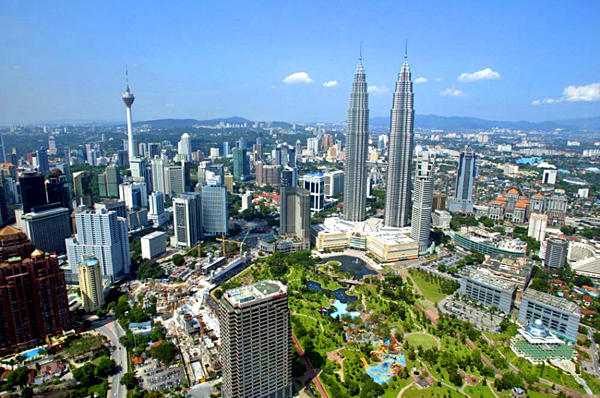Kuala Lumpur, aka KL, was my next stop on my trip. I know I'm writing this a bit behind schedule, but I'll try and get up to date here over the next week or so!
My coworker from Korea, Matt, had couch surfed with a local from KL (Mel) during his trip to SE Asia a few years back. While he was in Asia Mel visited and I got a chance to meet her in Seoul. I mentioned my trip plans and she said if I was heading to KL to let her know. When I arrived in the city she picked me up and drove me to her place. When Matt visited Mel lived further outside the city, but she had recently changed apartments. She was living with her brother Jason on the 27th floor with an amazing view of downtown KL. I could see the Petronas Towers, the tallest twin towers in the world, from their living room!
 |
| Downtown KL, highlighted by the Petronas Towers |
I hadn't planned to but ended up staying in KL for over a week. KL, and more generally Malaysia, often get overlooked by backpackers in SE Asia. I can understand why travelers would opt instead for the beaches of Thailand, but Malaysia also has a lot to offer.
The city of KL itself has some 1.5 million people, but the larger urban area is much larger, maybe 7 million. The best part of KL, for me at least, is the diversity of the populace. A plurality of the city is ethnically Malay, which is the dominate group in the country. Within Malaysia citizens of Chinese ancestry make up around a quarter of the population, but the number is above 40% in KL. There are also a significant number of Indians in the city, mainly ancestors of Indian laborers brought by the British colonialists. This mix creates unique food and cultural dynamics; all in one day you can have a traditional Malay breakfast, lunch in Chinatown, and an authentic south Indian style meal for dinner.
My favorite cuisine of the three is Indian. Many traditional south Indian style meals are served on a banana leaf (as opposed to a plate). Forks and spoons are provided for the less adventurous, but if you want to eat as it was intended, the only utensil you need is your hand. Just don't use your left - that one is for the bathroom! My favorite Malay dish is called Nasi Lemak - breakfast food comprised of rice, scallions, peanuts, and sometimes chicken in a spicy anchovy paste.
 |
| Nasi Lemak |
 |
| Banana leaf style - I need some practice with my hand! |
My host, Mel, is of Chinese descent, so I tended to try more Chinese food with her and her brother. Two highlights were lok lok, meat and veg on a stick eaten with a spicy peanut sauce, and a rice porridge with frog legs. I also tried some not so appetizing food - I definitely like some Chinese food, but there are many downright strange dishes. A mild example is stinky tofu. The taste itself was okay, but the smell so bad that I could barely stand within 10 feet of the food stand without gagging!
 |
| Typical reaction to the smell of stinky tofu! |
 |
| Mel (right) with me and some of her Malaysian friends |
Even though Mel's family has lived in Malaysia for generations they still speak Cantonese at home (their ancestors are from a Cantonese speaking region of southern China). I thought that they would have adopted the local Malay language by now, especially since they learn it in school. But her situation is not an isolated incidence. Many ethnic Chinese still speak Cantonese, Mandarin, or other various dialects from China. One of her friends who is ethnically Chinese but grew up speaking Malay has even been reprimanded by strangers for not knowing the Chinese language!
Over the week and a half in KL I visited several museums, each ethnic town, went out with Mel and her brother, and tried lots of food. One highlight was the Islamic Museum of Art. Another was Thaipusam, a Hindu festival. Participants marched 13+ kms from the city center to a series of caves. To show their devotion the marchers perform painful tasks - as simple as holding a small jug of milk on their heads for the duration of the journey, or as strange as piecing the skin with many metal rods. Some put them through their cheeks, nose, back - well pretty much anywhere! I went to the caves and watched the procession, but there were many more observers than actual participants.
 |
| Real devotion...count me out! |
 |
| Staircase leading to the Batu Caves |
While staying with Mel I also took an overnight trip to Malacca. Whilst KL is less than 150 years old, Malacca predates the early 16th century colonial incursions. The Portuguese took the city from local Muslim traders in 1511, but were usurped by the Dutch in 1641. Still later came the British, who were there to stay (until Malay independence in 1957). Although most of the Portuguese and Dutch colonial buildings were destroyed, remnants remain. A small section of the Portuguese fort remains, as does a church. The old Dutch town hall is now a museum. The city also has a vibrant Chinese community downtown. It was a nice, albeit quick, visit to Malacca.
 |
| The old Dutch town hall |
 |
| What remains of the Portuguese fort |









Comments